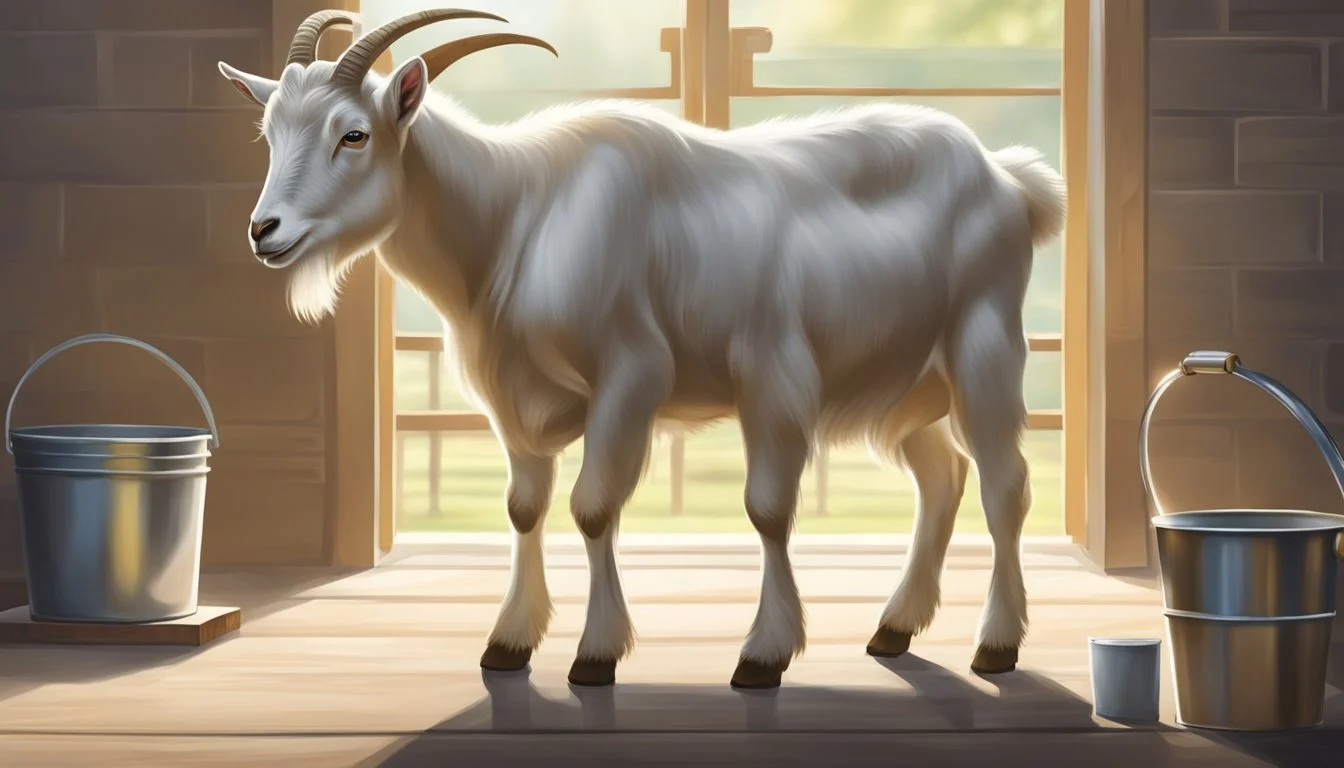How to Train Your Goat for Easy Milking
Mastering the Process with Expert Tips
Training a dairy goat for milking is an essential skill for small-scale farmers and homesteaders. Proper training ensures that the process is efficient and stress-free for both the goat and the milker. A goat that is well-acclimated to milking will stand calmly on the milking stand, allowing for quick and thorough milking. This leads to higher milk yields and a more pleasant experience overall.
Before beginning the milking process, it is important to have everything prepared and to understand the basics of goat anatomy and the proper technique for milking. Ensuring that the goat's udder is clean and that the milker's hands are also clean and warm will make how to milk a goat more effective and sanitary. The milker should be patient and gentle, as rough handling can be detrimental to the goat's well-being and may even reduce milk production.
Dairy goats require consistent routines to remain calm and cooperative during milking. Introducing young goats to the milking stand and the sensations associated with milking from an early age can facilitate this process. Positive reinforcement and a calm demeanor go a long way towards establishing a trusting relationship with the milking goats, creating a foundation that supports productive and easy milking sessions.
Understanding Goat Anatomy and Milk Production
Training your goat for milking requires comprehensive knowledge about their anatomy and how milk production occurs. This understanding will facilitate a smoother milking process and help maintain the health of your goat.
The Role of the Udder
The udder is an essential part of a goat’s anatomy, serving as the storage space for produced milk before it is extracted. It is composed of two halves, each housing a mammary gland. The health of the udder directly impacts milk production, as infections or issues can lead to a decrease in milk yield and quality.
Teat Basics
Each half of the udder has a teat, which is where milk is released during the milking process. Proper milking techniques are crucial to avoid causing discomfort or injury. The teats contain sphincter muscles that prevent milk from leaking out and are the channels through which milk is extracted when a goat is milked.
How Milk is Produced
Milk is produced in the mammary glands within the udder through a hormone-driven process, often initiated by the presence of a kid (baby goat) or by regular milking routines. The milk creation involves the transfer of nutrients from the goat's bloodstream into the mammary gland, where milk is synthesized. This process of milk production is continuous, as long as there is demand for the milk either by kids or through milking.
Setting Up Your Milking Environment
Creating an ideal milking environment is crucial for the comfort of both the goat and the milker. A well-designed space enhances the efficiency of the milking process, minimizes stress for the goat, and helps ensure that the milk stays clean.
Choosing the Right Milking Stand
The milking stand is the centerpiece of your milking environment. Selecting the right stand involves making sure it is sturdy and at a comfortable height for both the goat and the milker. The stand should have a secure headlock to keep the goat in place and a platform that is non-slip to provide stability for the goat. Additionally, including a feed tray can help keep the goat occupied and calm during milking. The stand should be accessible, with a clear path that allows the goat to walk straight to it and jump up without hesitation.
Maintaining a Clean and Organized Space
A clean and organized milking area is essential for the health of the goats and the quality of the milk. Ensure that the milking equipment, such as the bucket and strip cup, is sanitized before each use. The area around the milk stand should be kept free of debris and waste. After each milking session, it's important to clean the goat's udder and surrounding area to prevent the spread of bacteria. Store equipment in a designated area to avoid contamination and to make the process smoother. Regular cleaning and maintenance of the milking space help prevent mastitis and other health issues.
Preparation for Milking
Before training your goat for milking, it's essential to ensure proper diet and a calm environment. These integral steps will optimize milk flow and make the milking process smoother for both the goat and the handler.
Diet and Nutrition for Optimal Milk Flow
A goat's diet has a direct impact on milk production. For optimal milk flow, one needs to provide a balanced diet rich in protein and essential nutrients. Goats require a foundation of good-quality hay, which should make up the majority of their diet. This forage is vital for their digestion and overall health. In addition, a proper mixture of grains can enhance milk yield by fulfilling their energy requirements. It is essential to:
Introduce grains like barley, oats, or commercial goat feed to their diet.
Ensure fresh water is available at all times for efficient milk production.
A well-nourished goat will produce high-quality goat milk, so attention to their dietary needs cannot be overstated.
The Importance of a Relaxed Goat
A relaxed goat will yield milk more willingly and provide a higher quality product. Stress can significantly impact the quantity and quality of the milk. To ensure the goat remains calm:
Create a consistent routine to reduce anxiety during milking.
Handle the udderteats gently to build trust and avoid discomfort.
Ensure the milking environment is quiet and free from sudden disturbances.
A goat's relaxed state is just as crucial as its diet when preparing for efficient milking. Patience and gentle handling will foster a serene atmosphere conducive to abundant milk flow.
The Milking Process
Proper technique during the milking process ensures efficiency, promotes comfort for the goat, and maintains milk quality. Whether one chooses hand milking or machine milking, understanding the correct rhythm and method is essential.
Hand Milking Technique
To milk a goat by hand, one must first reassure the goat with a gentle touch and possibly a massage to the udder, which helps stimulate milk flow. Then, using a firm but gentle grip, the milker forms an "OK" sign around the base of the teat. Commencing from the top, they then squeeze downwards in a consistent rhythm, allowing milk to squirt out into the bucket or pail below without pulling or yanking, which could harm the goat or disrupt milk flow. It is key to maintain a steady rhythm and complete the milking process efficiently to ensure the comfort of both goat and milker.
Machine Milking Innovations
Machine milking has brought about innovations to the traditional hand milking technique. Advanced systems, like the Simple Pulse milking system, consist of components designed to mimic the natural milking action of young goats, providing a regular and gentle pulsation that encourages complete milk let-down without harming the udder. Users should be well-trained to operate the machine correctly, ensuring a consistent machine-derived rhythm that supports optimal milk flow and udder health.
Hygiene and Health Practices
Appropriate hygiene and health practices are pivotal to ensure safe goat milking. Adhering to these measures minimizes the risk of contamination and infection, protecting both the goat's welfare and the quality of milk produced.
Cleaning the Udder and Teats Prior to Milking
Before milking, it's vital to thoroughly clean the goat's udder and teats. Begin by using a single-use cloth or paper towel moistened with a sanitizing mixture to wipe away any debris or contaminants. Follow this with an iodine-based teat dip to reduce the risk of bacteria entering the milk. It's important to strip the teats 2-3 times to clear the milk ducts before collecting the milk.
Preventing Mastitis and Other Health Issues
To prevent mastitis and other health problems, consistent attention to cleanliness during and after milking is crucial. After milking, reapply the teat dip to protect against infections; the teat dip serves as a barrier, shielding the orifices from harmful bacteria. Frequent health checks and maintaining a clean living environment contribute significantly to the goat's overall well-being and milk quality.
Handling and Storing Milk
After successfully milking a goat, it's crucial to handle and store the milk properly to maintain its quality and safety. The following steps ensure that milk is filtered to remove impurities and stored correctly to prolong its shelf-life.
Using Strainers and Milk Filters
Before milk can be stored, it must be strained to remove any debris. A fine-mesh strainer should be used immediately after milking to catch any unwanted particles. Along with this, employing milk filters designed specifically for goat's milk can provide an additional layer of purity, ensuring that the milk is clean before it reaches the storage container.
Proper Storage in Glass Jars
For storing milk, glass jars offer a superior option due to their non-porous nature, which helps prevent the absorption of flavors and odors. They should be sterilized before use to eliminate any bacteria. After filtering, the milk should be poured into these jars, leaving an adequate space at the top to allow for expansion if the milk will be frozen. To minimize distractions and maintain a consistent routine, it's beneficial to have a dedicated space for storing the milk where it is easy to access yet out of direct sunlight and away from any strong-smelling foods.
Tips and Tricks for Efficient Milking
Efficient milking is crucial for a goat's health and productivity. By establishing a consistent routine and using effective techniques, one can optimize the milking process and increase yield.
Developing a Consistent Milking Schedule
Consistency is key when it comes to milking goats. It's important to start milking at the same times each day, whether it's once or twice a day. This habit not only helps in maintaining a steady milk supply but also keeps the goat calm and cooperative during the milking sessions.
Morning Milking: Begin early to align with the goat's natural lactation cycle.
Evening Milking: Schedule for the same time every evening to close the day with routine.
Techniques for Increased Milk Yield
There are specific techniques to enhance milk yield during each session. Proper udder massage and teat preparation can stimulate the milk let-down reflex. To achieve this:
Use a gentle touch to massage the udder, which helps in relaxing the goat.
Clean the udder and teats using a single-use cloth or paper towel before starting to milk, ensuring the goat's health and milk cleanliness.
To optimize each milking session:
Position the goat comfortably on the milking stand.
Support the udder with one hand while milking with the other.
Apply uniform and rhythmic pressure to extract milk efficiently, avoiding discomfort to the animal.
Conclusion
Training a goat for milking is an investment in both time and effort, but with patience and dedication, it leads to a rewarding outcome. Maintaining goat health is paramount, as it directly impacts the milk quality. A healthy goat is essential, offering nutritious milk that benefits every consumer.
The key steps to successful milking include establishing a routine, creating a calm environment, and being consistent with milking times. One should always start with clean equipment, ensuring the sanitation of the milking area to prevent contamination.
Proper handling and patience play crucial roles. Milking a goat may seem challenging at first, but a gentle approach helps in building trust. Over time, the goat becomes more comfortable on the milking stand, making the process smoother for both the goat and the milker.
Regular practice and adherence to these principles will not only ensure the well-being of the goat but also guarantee a steady supply of fresh, nutritious milk. Remember that each goat has its personality, and what works for one may not work for another; flexibility is key. Through consistent effort, the task of milking can be transformed from a chore into a pleasurable and fulfilling farm activity.






